Hotel rake: what you need to know in advance if you are making a conference room
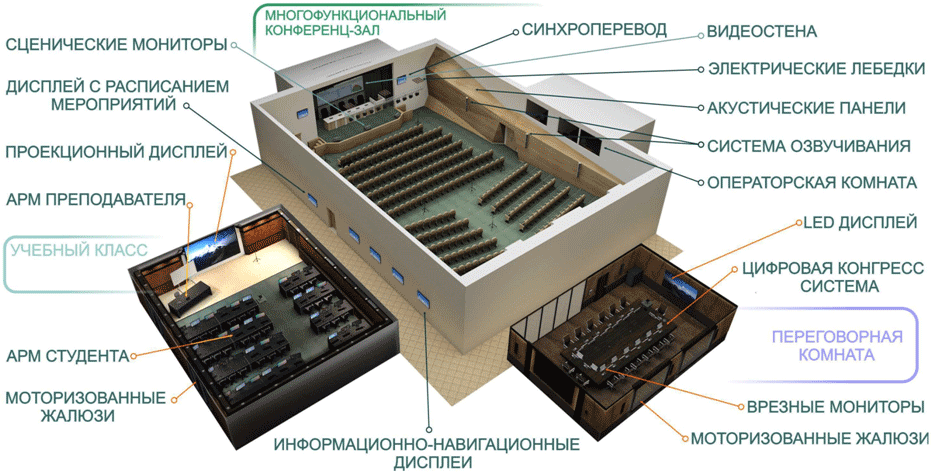
Doctors often complain that patients always pull to the last before coming to an appointment. We have about the same situation: multimedia equipment is usually put off until the very end of the repair of the floor with a conference room or at the end of construction. The usual picture of the connection is when the architectural project is already completed, the engineer is placed, everything is ready.
And then it turns out that the designer came up with everything in glass and marble, and you need to install special sound-absorbing panels (or very expensive speaker arrays). Are there panoramic windows on the sunny side? Hi, the projector is worth its weight in gold or an expensive curtain system. Low-level designers laid only one cable channel? Fine, we will shtroble marble or hang "snot" in the hall. Calculated the back-to-back ventilation? Hi, heat dissipation equipment.
And the budget at the hotel or hotel is the worst. And then it can be greatly reduced if you start the project a little in advance.
Short introduction
I am engaged in scoring different objects. My colleague already wrote about the temple and the stadium "Spartacus" . In general, such work by the standards of our team is almost space. Much more often we work not in places where we need to calculate an unusual sound, but in hotels and hotels where, in a minimum budget, we need to get comfortable conditions for people. More precisely - to think over the fastest possible payback period for the hotel owner.
The general situation is this - sooner or later the hotel understands that it is necessary to make a conference zone. This is usually a floor with a large hall where conferences, trainings, seminars, negotiations are held, less often - receptions, concerts, lectures and so on. Even weddings.
Usually the situation looks like this: for example, in one of the hotels where we worked, there was billiards and bowling on the floor. They made a good repair and turned the floor into a conference area. The audience changed to a business audience, occupancy rates increased, the hotel began to earn more, large events began to be organized every week. Plus, the zone itself made it possible to earn new money - regular seminars, trainings and something else are now held there.
On that project, we came to the stage when it was still possible to drive balls in billiards, so almost everything was done economically correctly. Usually they turn to much later, and what could be decided at the design stage with a designer or architect, or later, when finishing, is decided by expensive equipment or additional work.
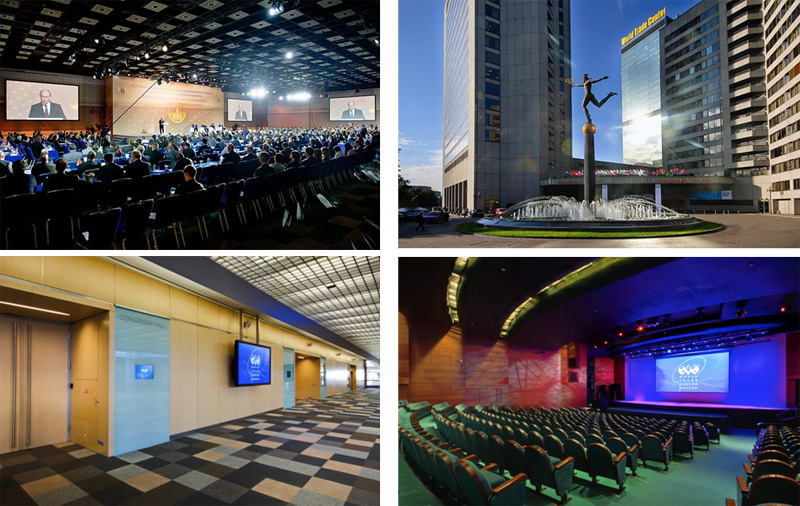
WTC
TK. First you need to understand very clearly why you need a room. If seminars are one set of requirements, and if performances of artists or balrooms are suddenly planned, this is different. The money in HoReCa is treated with care and affection, each ruble is an extra time to payback, therefore, it is most saved on the right technical specifications.
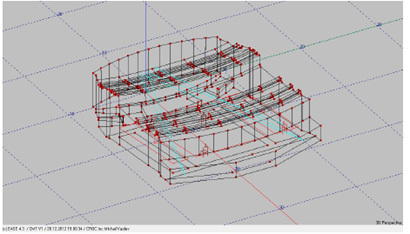
Acoustic model - EASE and Bose Modeler
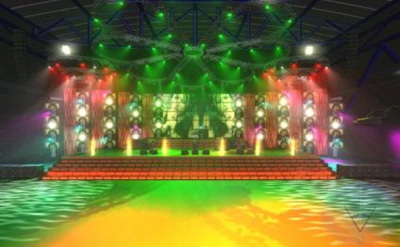
Lighting model - Dialux and LightConverse
The main factor is speech intelligibility. It depends on what materials were used (95%), and what kind of seating will be (to a lesser extent). With a major modernization, it’s better to immediately think about it.
Rake
Partitions. In most cases, a place that requires multimedia equipment is a large hall with the possibility of free arrangement of furniture. Most often, soundproof partitions are designed immediately, which allow you to divide it into several parts. This is important for conferences with different simultaneous speeches, various small events (a business breakfast in one part, a lecture in another). So, soundproof partitions usually calculate correctly and well, but forget about the raised floor and suspended ceiling. The fact is that the sound quite calmly “breaks through” the tile of the ceiling, passes into the adjacent hall in the subceiling space, and there it is already clearly audible. It is correct to make soundproof shields so that they do not interfere with ventilation, but at the same time do not pass sound. Of course, we must think about this before putting the hall into operation. It is important to consider the distribution: we had cases when they came with a request to remove the audibility in the rooms above the hall. During the events, they could hear everything the speaker said. Vacationers complained.
Lowers and sound. The general contractor rarely gives his work “to the side” - as a rule, if he has a team of low-voltage people, then even large halls are entrusted to them. But real experience and theory are two different things. In a simple case, low-voltage people simply misconfigure the hall, in a more complex case, they really know the theory, they all correctly believe, but they encounter undocumented functions of the equipment, which in my memory has repeatedly led to serious costs. The most common mistake is a long HDMI cable, 10-25 meters. On tests, it works great, but it is worth bringing a laptop and trying to connect to the projector, as it turns out that his video card is driving a weaker signal, which simply does not finish on this track. We were even called during events with a request to urgently fix something. Then we brought the equipment, but after that I had to pull the cable for $ 500 from the corrugation and lay a new track. Well, there were no gating.
The heat . A good bright projector can quietly emit 1.5 kW (and there may be several such projectors in the hall), active acoustics with a built-in amplifier also generate a lot of heat. They came to us with a project with a consumption of 30 kW and a heat dissipation of about 20 kW (there were still rotating light heads). And air conditioning was calculated exactly "penny to penny" under the maximum occupancy of the hall. People recruited, the iron turned on - and after an hour in the hall it was simply impossible to be.
Switching. When you need to change the configuration between events in the hall, you need to think about how this will be done. If there is a lot to mount, dismantle - you can not keep within an hour. If you just press five buttons and everything starts to work on its own, you can set events one after another, it’s profitable. A very convenient thing is motorized projection screens for projectors built into the ceiling, and elevators for projectors. These devices allow you to instantly switch from a conference format to a banquet format. Of course, they are useless without a centralized control system, through which an operator with a wireless control panel in his hands (in the budget version sold, including on the iPad) can "on the fly" change the configuration of the rooms and adjust the parameters (sound volume, equalization, brightness lighting, etc.).
Network. Rake all IT specialists “from the side” - we arrive at the site, ask where our 20 ports are on the switch. The manager looks at the documents, looks at us, again at the documents and then says that he did not foresee such things. But this is the most neglected case. More often it happens a little differently: the project company counted 3-4 ports, but in fact it’s necessary two times more by three halls in case of separation by partitions. Then there are two problems - the purchase in two stages (and you could get a discount when ordering at the same time) and problems with the food.
Nutrition. Iron consumes a lot of electricity. If you don’t know how much, much in advance, you may have to degrade the performance of the equipment, because you need to somehow fit into the available capacity. Another sore spot of power supply is grounding. There were cases when equipment began to fail along the control circuit. Measurements of the quality of the power supply yielded nothing, the voltage and frequency of the network were normal, but when we measured the potential difference on the ground between the equipment in the room and the rack, we intended 11 V, and periodically up to 15 V. As a result, the operating organization was recommended to organize a potential equalization system.
Shine. One of our “favorite” problems is when the designer picked up the light at such a temperature (based on his preferences) that with normal video conferencing, necessary for large events and negotiations, the colors are distorted. VKS requires a certain fairly narrow plug of color temperatures for comfortable work (so that everyone in the channel is about the same color), and the designer may not be aware of such use of the room.
Chandeliers. In such rooms sometimes very large chandeliers are hung. In practice, this means that the projector can go down very low to work with a large screen - or you need an expensive lens to fit near the screen. We had a case when a customer moved one of the chandeliers because it blocked the view. A similar problem - when the hall is being transformed, the partition is too close to the screen, you need to think about where the projector will be.
There is a hardware incompatibility factor- many examples when one equipment with another does not work correctly. There are nuances with the wiring of connectors: if you do not know in advance, there will be a lot of problems with commissioning. Experience of installations, experience of constant visits to exhibitions, annual certification from leading vendors - these things help a lot to avoid unnecessary delays and budget increases.
Plus, of course, problems with incorrect operation are added, especially at the stage of launching an object - for example, a control system, despite the fact that it becomes as concise and understandable for the user as possible, it is still quite complicated and the user can accidentally clutter the microphone. And then he calls us with a complaint that the sound reinforcement system is not working. Or here's another example - a technician calls one of the conference rooms and says that the projector is not working, does not show anything. It turned out that for some reason they gave the tenants of the hall a remote control from the projector, and they pressed the video mute button, by chance, of course.
Hotel upgrade specifics
When the hall is old, they often try to “pull it out” with minimal effort, replacing, for example, only an old projector. This is entrusted to those who are engaged in finishing, so then surprises happen. Most often, according to the readiness of the hall, it turns out that new equipment is needed, new equipment needs new switching, which means shifting all the tracks, changing the power supply scheme, and so on in increasing order.
Many hotels have their own standards, which are set by the network. Each owner of a particular building solves two problems at once: 1) keep within the standard, 2) in no case exceed it, because it will turn out to be more expensive. And the standard may be something like: “There should be a projector, an LCD screen, a microphone in each room.” Naturally, the switching system is not registered, there are no requirements for sound reinforcement, there is no minimum set of control equipment. In the USA or Europe, it goes without saying that no one will make a mixing console in the next room without a window to the room, and here we are. Or the light can be controlled from one place, the sound from the opposite end of the floor, and the curtain system through each window. Usually they simply set the task: a projector, a microphone and to work. Flexible switching - no. A little with a new event - and the customer calls the distributors, because he can not change the configuration of the equipment. For example, recently I regularly see that there is a VGA in the hall, and either the speaker from the iPad comes to the event, or you need to show the video from the bluetooth for the presentation, and there is nowhere to stick. Or you need to connect the videoconferencing for 5 minutes, and also nowhere to go. The hotel loses money, pays distributors for temporary installations, although at the project stage this would not have been very expensive.
By management - only those who have already understood why this is necessary put automation or script schemes. The fact is that in this situation, it’s not an IT specialist who is a shaman, not an engineer who runs on a cable, and the room manager simply presses one of the 10 signed buttons. And everyone is good.
Good practices
For many organizers of responsible events, it is very convenient to make automatic systems. It looks like this: SMS over time is thrown off to the robot or time is clogged through the web interface. In the morning, the system turns on, conducts a self-test, reports by mail and SMS. 20 minutes before the event turns on, warms up. From time to time, it turns on itself with a long simple - checks the resource. If, for example, a month is left before the lamp is changed, it reports this so that the admin has time to buy and replace. Recently, we have been delivering solutions that tie the work of conference rooms to accounting systems or Outlook - how the meeting is created, the hall robot is added there. The equipment will turn on and tune itself, a letter will be sent. Diagnosed in the morning. At the end of the year, the administrator will receive full statistics on usage and a forecast for the next year’s download.

About automation - in public areas of hotels it is often necessary that there are different lighting scenarios (morning, evening, foggy, wedding-conference, and so on), under them - light and music. If you don’t, then at first the staff switches the presets themselves, and then forgets about them. It is more correct to use motion and light sensors - this saves energy, comfort is higher. You can control your hands, but if you don’t touch anything for a long time, it’s worth turning on the automation again.
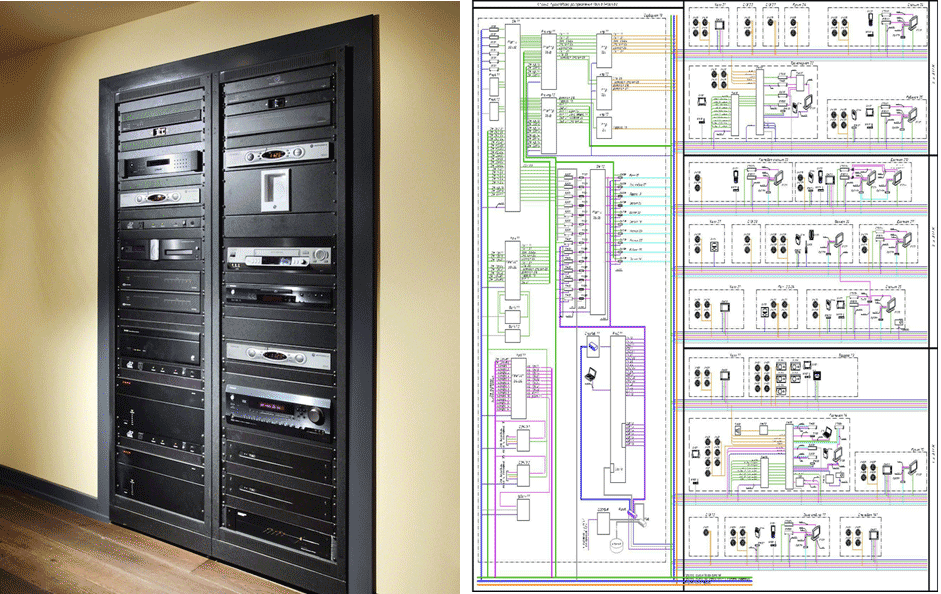
Sophisticated controller with automation
Recently, the issue of background voice acting has been very important. For expensive hotels, this system is usually divided with an emergency warning, or the speakers are of high quality. And where they save - the sound is ugly, or with two cheap separated systems, the voice acting does not shut up during an alarm. You have to manually turn it off.
In bars and other areas it is very important to put a good sound. Moreover, such as to cut off the table from each other with sound, but at the same time not to interfere with speech at the table. This is solved by equipment a little more expensive than standard - you can pay attention to acoustics in your favorite restaurants where this is found - very noticeable.
Many put a system of alerts and content management on the screens. You need to notify people about the bar on the 11th floor, the disco in the basement, congratulate the staff, and advertise the neighbors. The most telling example - there were 4 displays in a block in one hotel. The first is navigation (where and what, including at conferences), the second is outdoor advertising (a restaurant paid for it across the road and a local travel agency that gave a discount to hotel guests), an information block for its guests (“dish of the day - halibut”), then events. All this was done for the sake of happy hours in the bar from 17:00 to 18:00 - the bar was empty at that time, and began to fill up thanks to the screens. Well, plus additional profits.
Here is an example of background scoring:
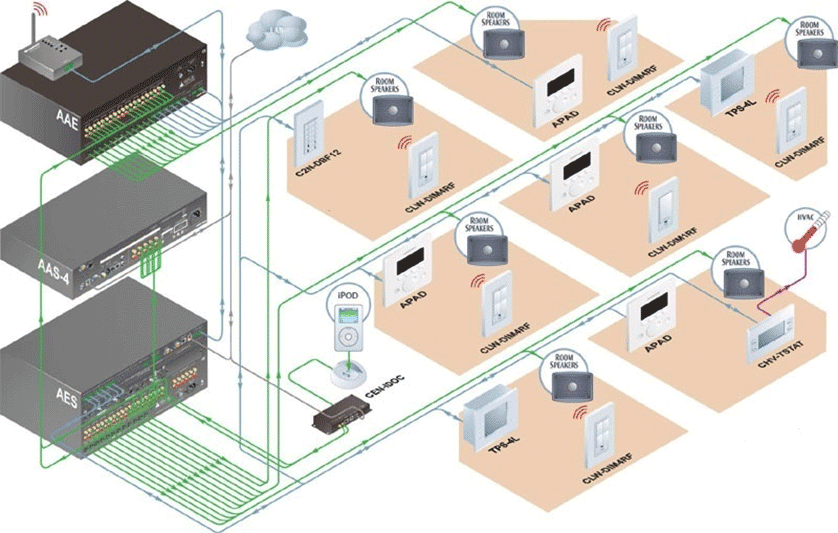

It is very bad to work when one company designs, installs another, and sets up a third in general. Someone should be responsible for the result and conduct field supervision.
Example 1: Hampton by Hilton - a business hotel in Volgograd

Movable soundproof walls allow you to divide the room into small conference areas. For high-grade and comfortable work, high-speed Internet was conducted, intuitive wall-mounted multimedia control systems were installed. Audio and video systems independently adapt to the mode of multimedia panels. You can change equipment settings using the iPad. Projection systems based on stationary AVStumpfl screens and NEC projectors; Enova AMX switching LED panels and NEC monitors; VKS Polycom; AMX management main and architectural lighting system based on LED modules; Lutron lighting control system; JBL stationary conference sound system; JBL mobile concert sound system, Soundcraft Si Expression mixing console; central audio switching device BSS London Architect; Bose background sound system; Showtec Concert Lighting System. Digital Signage AM X.
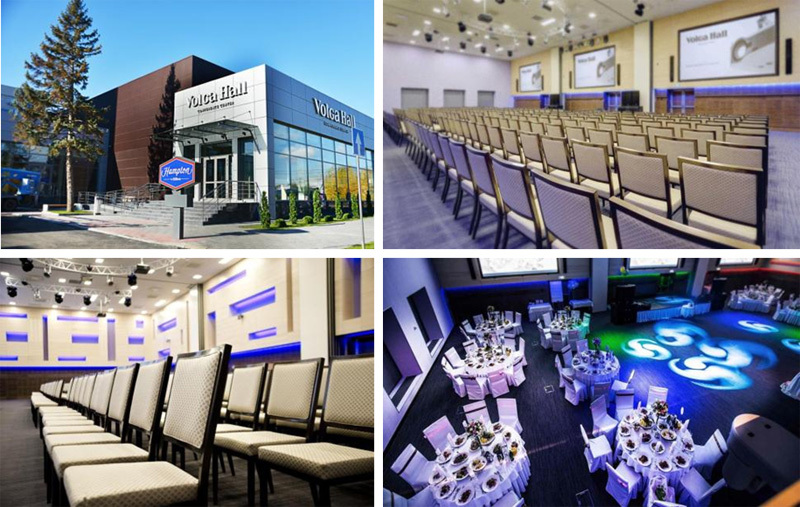
Example 2: Korston Hotel Moscow on the Sparrow Hills
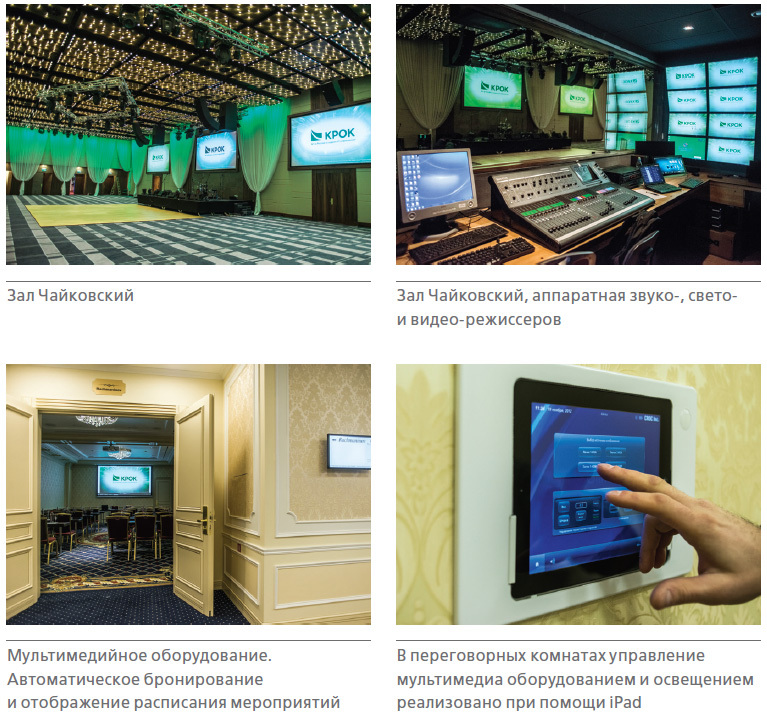
Flexible control of light and sound. Scenario management is automated: just select the desired type of event, and the system will automatically adjust the light. For the concert, LED lamps and halogen spotlights are turned on, spotlights from four different points are sent to the stage. For a seminar or conference, incandescent lamps are used that are built into the ceiling, this ensures uniform illumination of the hall. All concert equipment is located under the ceiling on electric winches for easy installation of additional equipment and convenient maintenance.
Example 3: Sochi - Rosa Khutor Resort
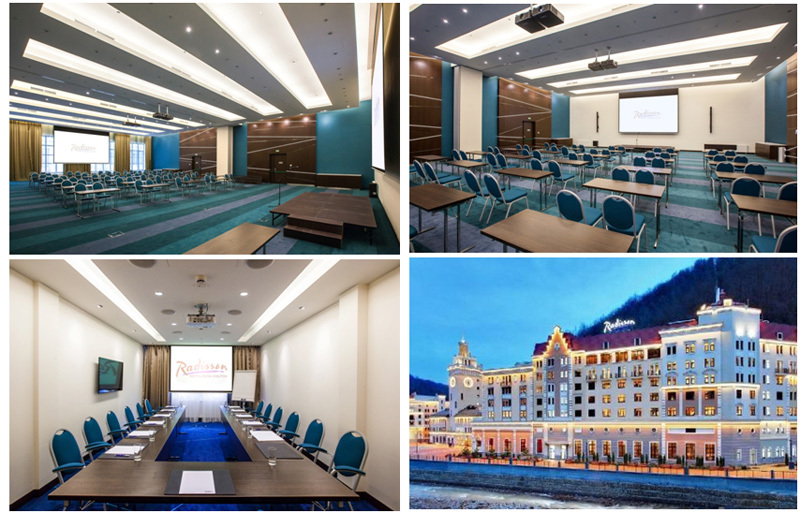
Radisson is one of the hotels in the Rosa Khutor group in Sochi
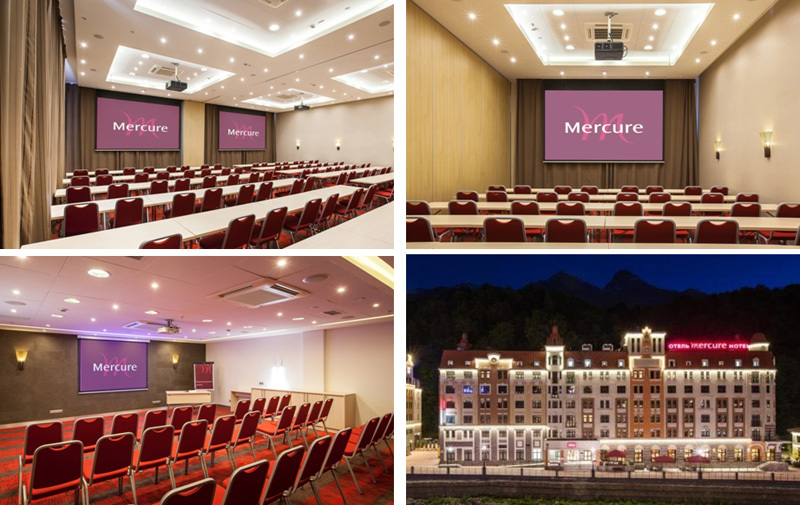
Mercury.
In the meeting rooms of hotels ranging from 30 to 340 square meters. m meetings are held with the number of participants up to 20 people, as well as large-scale conferences and banquets. In Radisson, a large hall, if necessary, can be divided into two parts using a mobile soundproofing wall. Projectors are combined using stacking technology. The soundproof wall, similar to the one introduced in the Radisson Moscow Hall, is also used in the St. Moritz and Chamonix conference rooms at the Mercure Hotel, as well as in the Golden Tulip Rosa Khutor conference room.
In all rooms, the sound and video from the projectors are controlled using the touch panel on the iPad. The control system allows you to automatically switch the operating modes of the halls depending on their configuration. Sensors track the position of the mobile partition, and the central processor, which receives the signal, rebuilds the operation of audio and video equipment.
Golden Tulip Rosa Khutor uses universal mobile multimedia equipment kits designed to save space in the hotel. These racks can be connected to specialized modules in any room of the hotel and can turn it in this way into a functional conference room.
There was still an interesting case. To save money and increase the reliability of the system, we sometimes put a solution of two projectors on one screen. There is the possibility of pixel-by-pixel combination, this is not a problem. And the benefit is that projectors can cost 3 thousand dollars apiece, while high power is twice as much - 10 thousand. Plus, if one falls out accidentally, the second will remain. Savings and reservations.
So we put such a system in Sochi. A month later, they complained that the picture "floats" a little. They sent an engineer, he brought back. In a month - again. They began to dig, began to look, when there were desync by dates. It turned out that these days there were small earthquakes that were not even felt. And the projectors stood on independent bars. Fastened to each other - the picture did not change. After some time, there was a montage in one office in the region - there, in general, when the tram passed, the table jumped, they remembered.
More rake
Here, in the standard for a hotel, the brightness of 3 thousand lumens per projector is prescribed. The one who wrote this, apparently, thought that all the halls were standard. The reflected brightness a certain number of times should be higher than the illumination. If the lighting is 250 lux, you need, for example, 700 lux reflection. The hall is large, the screen is 4 meters by 3 meters, that is, 12 meters of area. 3 thousand lumens from a projector is a plus or minus 250 lux of reflection under normal conditions. That is, the brightness perfectly matches the illumination of the room - black and white do not differ. They only worked in this room with the lights off ... Until the conference began, where people wrote in notebooks, they had to increase the brightness of the projector and make a spotlight.
The second case - the type of screen is not spelled out in the standard. A large screen is bought, and the projector remains old, from the last room. In that hall, I was lucky - hotel guests came, looked around, said "change the projector or do not do it at all." Changed. And they could have kept silent - then for another six months the hotel would not have known why the customers were not coming.
Often do not provide a screen for the presenter or presidium. As a result, five people sit in front of the hall and turn their heads wildly backwards. Or a duplicate monitor is at the bottom, and no one ever sees a speaker with eyes in the room.
Often you have to deal with the feedback effect: put omnidirectional microphones on the presidium table - and hang the ceiling speakers from above, the microphones at the same time, of course, begin to “wind up”.
It often happens that you have to stupidly replace the matrix switch, because you put 4x4 without a margin, and you need two more inputs and outputs. The difference in price frightened at first, and when it was necessary to connect something “blood from the nose” - there was nowhere to put the old piece of iron.
In one small hotel I saw how the builders mounted everything on their own, but for some reason no one told them that a cable should go to the projector.
In a large solid room I saw how the hatches were incorrectly placed in the floor for outlets and chargers - a round table, and two snot from the wall stretched towards it - power 220V and HDMI.
I saw bets only on a wireless network, when any accident drops the entire event.
Probably the worst thing was a motorized screen that drove out of the ceiling. So, the architect and the engineer designer didn’t agree somewhere, and this screen closed the front door. Someone was late - the speaker stops, raises the screen, lets in. Someone wanted to use the toilet - the same procedure.
PS I will be happy to answer questions in the comments or, if they relate to specific projects, by mail PPochtennov@croc.ru.
